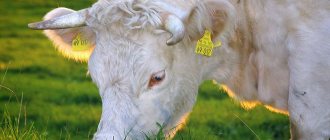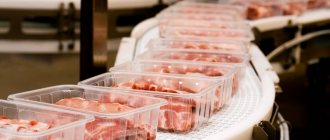In this material:
- Description of the cattle breeding business Relevance
- Products
- Fattening
- Tax system
- Farm arrangement
- Attachments
Cattle breeding as a business is a profitable and quite promising area of entrepreneurial activity. Today, the cost of high-quality beef on the market is constantly growing, as are the prices for milk and dairy products. Accordingly, it is not difficult to find a point of sale for such products. But in order to prevent disastrous mistakes during the implementation of this type of activity, it is important to create a detailed business plan already at the stage of project preparation.
Description of the cattle breeding business
This type of business activity involves raising cattle for the production and further sale of meat and dairy products. At the initial stage of the project, it is planned to purchase young animals with their subsequent rearing. At the same time, the high profitability of the business is a consequence of its relevance.
Relevance
The relevance of this project is explained by the fact that since the times of the USSR, almost all state farms involved in cattle breeding have been liquidated. Existing private farms are not able to fully satisfy the population's demand for such products. Accordingly, beef and milk of average quality are purchased abroad. In addition, the number of genetically modified products on the market is increasing.
Reference. Due to the above points, the cost of natural domestic beef is steadily increasing. In addition, the state provides certain subsidies for this branch of livestock farming.
Products
Before opening your own cattle farm, it is important to decide what products it will specialize in. The most relevant are three main areas of livestock raising:
- Breeding dairy cows. Many farmers start their business with just such activities. Income comes from the wholesale or retail sale of milk and its processed products.
- Beef cattle breeding. For such an enterprise, calves of special meat breeds are purchased. Significant profits in this direction should be expected only if the fattening of young animals is properly organized.
- Sales of young cattle. This type of business is especially in demand when the farm raises particularly valuable breeds of livestock.
An entrepreneur can receive additional profit from selling manure. Some cow breeds are also prized for their long, thick hair. It is used for the production of technical fabrics.
Keeping chickens
Thinking, you don’t need to talk a lot about the advantages of cage housing over floor housing. This saves space (cages can be arranged in several tiers), saves on feed, and the birds get sick less. In addition, it is easier to organize egg collection. So, in the conditions of LPH or KFH, cells are the best option. A reasonable question is: how long can you keep birds in one room? Many poultry farmers adhere to the calculation of 10 chickens per square meter. That is, to keep 500 chickens you will need a room of at least 50 square meters. m. Cells can be made independently. There is plenty of information on this matter on the Internet.
If you have “extra” money, then there are ready-made cell modules for sale. For example, to keep 500 chickens, you can purchase ten three-tier cages, each of which can hold up to 55 chickens. The big plus is that the cages are already equipped with everything necessary for the comfortable keeping of birds: nipple drinkers, feeders and an egg collector.
The height of one cell is 180 cm and the width is 130 cm. The asking price is 19,000 rubles. for one cell or 190,000 rub. per set.
Meat and dairy cow breeds
When choosing a specific farm specialization, you should immediately decide which cattle breeds will be bred. Each direction has its own list of the most popular breed lines. In the meat sector, the following are in demand:
- Hereford. This breed originates from England. Its representatives are widely popular due to the high slaughter yield and marbling of beef. The average weight of a bull is 1.1 tons. The height of the animal reaches 1.5 m.
- Aberdeen Angus. Beef also has a high price due to its marbling. The breed was developed in Scotland. The weight of a bull varies between 900–1000 kg.
- Kalmytskaya. Representatives of the breed are hardy, unpretentious, and have a pronounced meaty build. The weight of adult bulls is 850–1000 kg. The slaughter yield of meat from a carcass is 60–67%.
Among the popular dairy breeds, the following varieties are especially valued:
- Black-and-white. Such cows were bred in the Urals and Siberia (separate subspecies) based on the Dutch breed of cows. The living creatures are distinguished by their endurance and rather dry constitution. Milk productivity is 3500–5000 kg.
- Yaroslavskaya. A domestic variety of cattle, which was bred in the Yaroslavl province. It is characterized by high milk production, varying from 2700 to 3500 kg. The fat content of the products is 3.7–4.2%.
- Holstein. This Dutch breed of cows is most popular in the dairy sector. The productivity of such cows exceeds the mark of 6–7 thousand kg. At the same time, the fat content of milk is 3.2–3.6%.
Attention! These breeds are designed for a specific area of productivity. Therefore, meat varieties have significantly lower milk yields, while dairy varieties have lower quality meat. Therefore, if a breeder plans to earn income from two directions at once, it is better to pay attention to universal breeds.
Technology of raising chickens for eggs
To establish the production of chicken eggs, the following requirements must be met: the process of raising poultry must be highly productive and the products must be supplied evenly throughout the year. For this purpose, it is necessary to use highly productive breeds of laying hens, which must be kept in windowless poultry houses, raising eggs must be year-round, constant replenishment of the herd is necessary, and modern technologies must be used. In order for egg production to be productive, several factors must be observed: good lighting, temperature, room humidity and cleanliness of the poultry house. The temperature in the poultry house should be no lower than 16-18 degrees Celsius, air humidity should be 60-70%. The productivity of eggs is also affected by the cleanliness of the poultry house, since in an uncleaned room gases are released from the decomposition of manure, which affect the appetite and general condition of the bird. The productivity of laying hens is also affected by the dustiness of the poultry house; in the summer it must be equipped with powerful fans. Poultry houses are stocked with chickens of the same age and approximately the same weight. From the purchase of chickens to the appearance of eggs, 120 days pass.
Features of livestock breeding
To minimize the risks when raising and keeping cows, the breeder must study in detail the features of breeding such animals. Without proper feeding of cattle, it is unlikely that a farmer will be able to achieve high productivity indicators. And without them, the profit from such activities is reduced significantly.
Fattening
When breeding cows, an important point is to provide them with the proper diet. A suitable option for feeding calves is selected based on their breed and the purpose of the herd.
On meat breeding farms, as a rule, two types of fattening are practiced:
- Grain. The diet of cows includes high-calorie grain feed from wheat, corn, and oats. This approach to feeding contributes to rapid weight gain and the appearance of marbling in meat.
- Herbal. With this feeding, the basis of the animal’s menu is grass and hay. The beef becomes lean, but contains a large amount of vitamins.
The second option is especially popular with breeders who have extensive pastures at their disposal.
For dairy-producing cattle, the diet should be more varied. In addition to grass from pastures, the following is also used in feeding calves of these breeds:
- fodder beet;
- grain and products of its processing;
- combined feeds.
Their use allows you to increase the cow's weight gain and achieve high productivity indicators.
Slaughter
If the purpose of the farm is to raise cattle, then it would be useful to equip your own slaughterhouse on the territory. In this case, it is necessary to allocate a separate room in which the slaughter line and refrigeration rooms are located. If there are also livestock farms in the neighborhood, you can save a lot by equipping a common slaughterhouse.
Calves of beef breeds are slaughtered when they are 14–16 months old. At the same time, it is implemented manually or using special equipment.
Registration of activities
Organizing your own cattle breeding business involves generating a certain income. Accordingly, such income is subject to taxation, and the enterprise itself requires official registration. The most acceptable option would be to register the enterprise as a peasant farm. Peasant farming involves the possibility of renting larger plots of land, receiving government support and certain privileges. In this case, registration of a legal entity as an individual enterprise or LLC is also required.
Tax system
After registration, the entrepreneur is given the opportunity to choose the appropriate taxation regime. The standard general regime (OSNO) is inappropriate because it involves too complex reporting. Much more often, beginning farmers choose the unified agricultural tax (USAT), according to which 6% is transferred to the budget from the entire gross annual income of the enterprise. The conditions in such a system are more favorable, reporting is simplified. In addition, local authorities have the right to tax some farms at 4% of their total gross income.
List of documents
Official registration of a farm is carried out only if the breeder has a mandatory package of documents. It should include:
- application for registration of peasant farm;
- breeder's passport;
- a copy of the identification code;
- statement on the choice of a suitable taxation system;
- receipt of payment of state duty.
Also, to open a business, the head of the farm will need permits from the sanitary and epidemiological station and fire inspection, and a certificate of satisfactory condition of the animals from the veterinary service.
Poultry farm design
When it comes to serious volumes, the poultry farmer has a completely logical question - is it worth registering a poultry farm or is it better to work as a private household plot? In principle, when keeping a livestock of up to 500 heads, there is no point in registering a peasant farm (or individual entrepreneur). You will simply create additional problems for yourself related to filing reports, paying taxes and pension contributions. When is registration required? The point is this. When you sell products grown on your plot, in a regular market, from a tray or from a car, no one will fine you for it. In fact, you are equivalent to those thousands of grandmothers who sell strawberries in cups. They don’t register IP. It’s another matter when you have large sales volumes, for example, a thousand eggs a day. It is difficult to sell such a volume from a tray alone, so most likely you will prefer to sell eggs in bulk to stores or for processing. And here they will ask you for documents, since every supplier is an entrepreneur (at least according to the law). No store will buy from you without documents, as it also risks receiving an administrative fine.
Organizational plan
A business plan for cattle breeding must necessarily include an organizational plan. It describes in detail such aspects as the purchase of young animals, equipment, feed, as well as the general nuances of setting up a farm.
Farm arrangement
It is advisable to organize your own farm in farm buildings left over from the times of the USSR. This will not only save the breeder a lot of money, but will also eliminate the need to obtain various development permits.
Important! The dimensions of the room are selected strictly according to the number of heads of livestock. For every 10 individuals, an area of 34x6 m is required. It is also important that next to the spacious barn there is a large pasture and there is a place to build warehouses for food supplies.
After selecting a suitable site, its arrangement is carried out. The premises in which the livestock will be kept are equipped with high-quality ventilation, insulated and repaired if necessary. If you plan to keep a large number of beef cows, you need to equip durable stalls. The area of each of them is 2 square meters. m. It is also necessary to organize systems for the outflow of manure from the premises, to equip each stall with feeders and drinkers.
Purchase of young animals
To organize your business, you need to purchase a healthy number of livestock. At the same time, its composition and number completely depend on the chosen business development strategy. For beef cattle breeding, one-month-old calves are purchased. For the production of dairy products, they often take already grown cows, but in this case it is important not to make a mistake, since the cow produces significant milk from the age of 3 and up to 11–13 years.
It is important to choose the right place to purchase young animals. A small number of calves or young dairy cows can be purchased from private farms. You should also pay attention to similar existing peasant farms with a good reputation.
Livestock feed
Even before purchasing calves, care must be taken to purchase a sufficient amount of feed. To keep cattle you should stock up on:
- hay;
- root vegetables: potatoes, carrots, fodder beets;
- grain and products of its processing: corn, wheat, barley, flour, cake;
- silo.
In the warm season, the basis of the animal’s diet is fresh green grass. Therefore, it is necessary to take care of the availability of free areas of meadow for mowing.
All feed must be of proper quality. They are stored in a dry place, inaccessible to rodents.
Necessary equipment
Caring for livestock on a large farm is simply impossible without the appropriate equipment. Therefore, you should additionally purchase for the farm:
- a vehicle for transporting manufactured products;
- refrigeration chambers for storing meat and milk;
- feed dispensers;
- stall;
- machines for trimming cows' hooves;
- milking machines;
- tools for caring for livestock and cleaning barns.
It would also be a good idea to purchase your own tractor with a set of attachments. This technique will significantly simplify the process of making hay.
Benefits of a Home Mini Farm
A home mini-farm is a unique find for housewives who dream of their own harvest all year round. Main advantages of the set:
- safe composition of the grown crop;
- short ripening periods;
- does not take up much space;
- does not require increased care;
- does not involve cash investments;
- high harvest volumes per year;
- absence of pesticides and chemical treatment;
- The fruits are juicy and pleasant to the taste.
Financial calculations
One of the main points of any business plan is the calculation of the financial side of the enterprise. Based on its detailed study, one can judge the feasibility of opening such a business.
Attachments
To open a cattle farm from scratch, you need considerable start-up capital. If, to begin with, about 20 heads of livestock are purchased for a farm, then at the initial stage it is necessary to invest at least 5–8 million rubles in it. This amount includes costs for:
- farm registration;
- land lease;
- construction or renovation of buildings;
- purchase of young animals and equipment;
- conducting communications;
- purchase of feed.
Current expenses
You should also take into account operating expenses, which include:
- costs of transporting products and feed;
- staff salaries;
- Payment of utility services;
- replenishment of feed supplies;
- pasture rental.
The amount of such investments per month is at least 250 thousand rubles.
Income from product sales
As already noted, in this line of business, income can be obtained from the sale of meat, milk, and skins. Individual farmers purchase cow dung in large quantities. Taking into account current prices for all of these types of products, the annual income from such an enterprise will be from 7 to 8 million rubles. The monthly income of the farm will be about 650–750 thousand rubles.
Profit calculation
If the operating expenses for each month are subtracted from the total monthly income from the farm, the breeder will get the business profit value. Taking into account the above provisions, for a farm with 20 heads of livestock, this amount will be approximately 400–450 thousand rubles.
Poultry farm constant costs
- Utility costs (electricity) – 4,000 rub.
- Feed – 15,000 rub.
- Vitamins, supplements, bedding – 1,000 rub.
- Packaging – 5,000 rub.
- Fuel and lubricants – 9,000 rub.
- Other expenses - 5,000 rubles.
Total - 39,000 rub. Please note that all calculations are approximate and each individual farmer will have different indicators. For example, in these calculations we did not take into account labor costs, since the farmer will work independently (using the labor of relatives). If you hire an employee, you should add at least 20,000 rubles to the costs. per month. Also, feed can be purchased at different prices, especially if purchased out of season. Now you can calculate your expected income.
Profitability of cattle breeding business and payback
If we take into account the stated financial expenses and profits, we can conclude that within 1.5-2 years the enterprise will fully pay for itself. Thus, the profitability of this type of business activity will be from 62 to 65%.
Breeding cattle, with the right approach, can become a fairly profitable business activity. Beef and dairy products have high prices on the market. In addition, the breeder receives a certain income from the sale of young animals, skins and manure. At the same time, the large investments required to open a farm pay off within 1.5-2 years.
The poultry market is the main issue
Raising poultry on your own farm is not difficult. One family of 2–3 people can easily support up to 5,000 laying hens. That is, get up to 3500 - 4000 eggs daily. But, before investing in a poultry farm, you should carefully think about how and where you will deliver so many eggs (or meat, if the direction is meat). Because so many beginning farmers got burned in sales. Even if a homemade egg sells out within a year, selling it is a very troublesome business. Just imagine. You need to get up early every morning, collect eggs (several thousand!), put everything into cassettes, go to the veterinarian so that he can give an opinion on the batch, and only then take it to the market, where it all needs to be sold. You can, of course, do without a veterinarian, but if you have large volumes, sooner or later law enforcement agencies will have questions for you. Because you will no longer resemble an ordinary private household plot (which gets away with everything), but like a natural agricultural production. Therefore, calculate everything in advance, go to the local market, find a place. Go to grocery stores and specialized kiosks and offer cooperation. It might make sense to consider the option of traveling from a mobile store. For small volumes (less than 500 eggs per day), it is quite possible to get by with classic trading from a machine or a tray at the market. Trade in eggs and poultry through bulletin boards, in particular through Avito, is now quite common. In general, it is quite possible to earn a stable income on message boards if you know what and how best to sell and constantly update texts.











